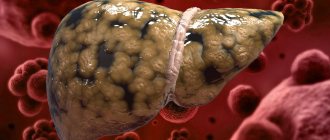When digestion is disrupted, gases begin to accumulate in the stomach, which leads to bloating (flatulence). A person feels full, and the stomach becomes round and increases in volume. Some gases enter the digestive system from the blood. The largest percentage of gases accumulates in the stomach and the flexures of the colon. The smallest volume of gases is observed in the sigmoid colon and small intestine.
Causes
Causes of bloating not associated with other diseases:
- Hypolactasia (lactose intolerance). A certain category of people cannot digest milk sugar, since there is no enzyme that breaks down lactose. If a person with hypolactasia eats dairy products, he will experience indigestion, flatulence, and diarrhea.
- Binge eating. If the serving size for one meal is too large (the norm is determined individually), bloating will appear. Flatulence is caused by salty foods. Food with a high salt content leads to water retention in the body's cells, which is why flatulence is observed.
- Consumption of foods that cause gas formation. Foods with large amounts of starch, carbohydrates, and fiber increase gas formation. If you eat a lot of rye bread, potatoes, cabbage, peas and other legumes, the risk of flatulence increases significantly. Bloating also occurs due to the consumption of carbonated drinks, raisins, fruits and berries that are prone to fermentation processes (grapes, cherries, apples).
- Irritable stomach syndrome (IGS). The disease is characterized by impaired intestinal motility. Because of this, movements in the stomach become inconsistent, which leads to the formation of gas. Along with bloating, severe pain, diarrhea or constipation occur. In some cases, disorders may be asymptomatic.
- Quick meal. In the process of eating food, a person absorbs a certain amount of air. This indicator increases when having a quick snack or talking while eating. The gastrointestinal tract has a feeling of overeating. Gas formation is accompanied by nausea, as well as sharp, albeit short-lived, pain.
- Pregnancy. In recent months, women feel bloated. The uterus becomes larger and begins to put pressure on the intestines. Because of this, the tone of the organ decreases, peristalsis worsens and the movement of food through the esophagus slows down.
- Pneumatosis of the stomach. The disorder occurs due to regular swallowing of large volumes of air while eating. Usually a person is in a hurry and does not chew food well, which is why much more gas accumulates in the intestines than with leisurely and calm absorption of food.
- Constipation. When a person eats only solid food and drinks little water, problems with stool may occur. Along with this, flatulence also appears.
Diseases of which bloating is a symptom:
- Digestive problems. The reasons lie in malabsorption, enterohepatic circulation, and lack of enzymes. If food is poorly processed at the beginning of the digestive chain, then a large amount of gases appears in the intestines during the breakdown process.
- Changing eating habits. This is a typical problem for babies whose diet is introduced to complementary foods or when breast milk is replaced with artificial cereals. At this time, the child has difficulty digesting and absorbing milk, since the functioning of the intestines has not yet been established.
- Intestinal dysbiosis. If the ratio of bacteria is disturbed, a feeling of heaviness, diarrhea, flatulence and other symptoms are observed.
- Intestinal obstruction. In parts of the digestive system, adhesions, tumors, stenosis and other obstacles arise that interfere with the movement of food. Stagnation often occurs, during which fermentation begins and gases are formed.
- Acute intestinal infections. These include helminthic diseases and salmonellosis. During the process of intoxication, intestinal motility is disrupted, which leads to bloating and other unpleasant symptoms.
- Mental problems. Frequent stress, depression, mental disorders, nervous system disorders lead to digestive disorders. When the nervous system is often overexcited, spasms form in the intestines, disrupting peristalsis.
- Inflammation of the digestive system. The intestines respond with flatulence when the functioning of any organ in the digestive chain is disrupted. Bloating can be a symptom of Crohn's disease, cirrhosis, pancreatitis and other diseases.
- Problems with blood circulation. If blood stagnates in the vessels and intestines, circulatory bloating appears. This process is a symptom of liver cirrhosis and abdominal ischemic syndrome.
What is flatulence
When excess gas accumulates in the intestines, this is flatulence. The appearance of gas masses in the body is not a pathology. The digestive tract of a healthy person contains about 1 liter of gases, which include:
- nitrogen: up to 90%;
- carbon dioxide: from 4.3 to 29%;
- oxygen: from 0.1 to 23%;
- methane: from 0 to 26%;
- hydrogen: from 0.6 to 47%;
- hydrogen sulfide, ammonia, volatile mercaptans.
Most of the gases in adults and children are formed as a result of the breakdown of food and the vital activity of microflora living in the digestive tract. In addition, the cause is the air entering the body when a person breathes through the mouth, swallows food, smokes, chews gum, or drinks through a straw.
Another reason for gas formation is carbon monoxide, which is formed when gastric acid is neutralized with alkali (pancreatic juice). These gases are absorbed into the blood through the walls of the stomach or go into the intestines. When there are too many of them, they come out through the mouth. This is how a belch is formed.
Intestinal gases leave the body through the rectum, belching, and as part of exhaled air. During the day, an adult removes from 100 to 500 ml of gas from the body during bowel movements and in addition to it. With flatulence, these figures can exceed 3 liters.
Symptoms
The main symptoms of bloating are a feeling of heaviness, bloating, pain, heartburn, diarrhea, and constipation. Painful sensations can be paroxysmal or cramping in nature. If there is a malnutrition, then belching appears with an unpleasant aftertaste. Problems with stool arise individually, depending on the characteristics of the digestive system.
Unusual symptoms of flatulence include arrhythmia, weakness, headache, dizziness, and drowsiness. Sometimes there is a burning sensation in the area of the heart and a disturbance in the heartbeat. The mental state also suffers against the background of bloating, the person is depressed.
Types of flatulence depending on the course of the disease:
1 Gases accumulate in the intestines and do not escape. This process is accompanied by severe pain, constipation and a general deterioration in health.
2 Excess gas is released from the rectum. The process can cause discomfort and reduce activity. But the person does not complain about health, pain or problems with stool.
If flatulence is accompanied by constant intense abdominal pain, you should consult a doctor. Medical help will be required if there is significant weight loss, nausea, vomiting, or blood in the feces. An ambulance is called when there is an increase in temperature and pain in the heart area, since swelling in this case signals serious illness.
If flatulence is observed for a long time, then symptoms of intoxication will gradually appear. Increased gas formation leads to problems with sleep, general malaise, mental disorders, headaches and signs of poisoning.
Clinical manifestations
Flatulence is a whole syndrome that includes not only increased gas formation and bloating. The following phenomena may be observed:
- Feeling of heaviness in the stomach. Directly proportional to the volume of accumulated gases.
- Pain. Painful sensations arise due to compression of internal organs by stretched intestinal loops, when large vessels, nerve trunks, etc. are pinched.
- Intestinal colic. Overstretching of the intestinal wall provokes irritation of multiple receptors and the implementation of a response - a sharp contraction of all smooth muscles. During an attack, the pain can be very severe, but not long-lasting.
In more rare situations, constipation or diarrhea with massive discharge of gases, decreased appetite due to stagnation of feces and intestinal intoxication may occur.
Expert opinion
Shubin Mikhail
Gastroenterologist, site expert
Strong pressure on the diaphragm is dangerous. Compression of many nerve fibers and organs of the chest contributes to the appearance of symptoms from the cardiovascular (increased blood pressure, tachycardia) and respiratory systems (shortness of breath, decreased depth of breathing, development of pathological types of respiratory activity).
Severe flatulence is quite capable of causing gastrointestinal bleeding, hernia formation, intestinal rupture with symptoms of peritonitis.
After the passage of gases, the general condition, as a rule, normalizes, and clinical manifestations disappear.
Should I call an ambulance if I have bloating?
Bloating is an absolutely harmless symptom to human health and life. Antispasmodic and adsorbent medications will help cope with flatulence. 20-40 minutes after administration, the problem subsides. You can get rid of pain after going to the toilet. If the pain remains, it may be a symptom of a disease that requires medical intervention.
What does prolonged intense pain indicate:
- Acute appendicitis;
- Inflammation of the peritoneum;
- Intestinal obstruction;
- Apoplexy (ruptured ovarian cyst).
If you suspect the above diseases, you should urgently call an ambulance. It is better to diagnose and prescribe treatment in the first stages.
Diagnosis
Flatulence in adults - causes and treatment at the first aid stage, discussed earlier, can become a knowledge base for a diagnostic search.
It should be based on the study of:
- complaints - the nature of clinical manifestations, duration, moment of occurrence, methods of relief;
- history of the disease - time of onset of the disease, total duration, previous treatment methods and their effectiveness;
- examination of the patient - the presence of an increase in the size of the abdomen, assessment of the color of the skin and mucous membranes, body temperature, pulse and respiratory rate - is aimed at identifying the etiological factor;
- laboratory indicators - general analysis of blood, urine and feces, study of the enzymatic activity of digestive juices;
- instrumental research methods - ultrasound of the digestive organs, contrast radiography, FGDS.
Negative effects on the body
- Flatulence directly causes physical discomfort.
- Bloating indirectly affects your mental state.
- More energy is spent on digesting food, so the load on the body increases significantly. The body works with double strength, but does not receive the necessary nutrients. Because of this, you feel constant hunger. A person subsists on small snacks, which makes the situation even worse. As a result, extra pounds appear.
- Constant digestive problems have a negative impact on mental health. A person becomes irritable because he experiences discomfort.
- Skin problems also appear, immunity decreases, and chronic diseases arise.
Diagnostics
To find out the exact cause of bloating and increased gas formation, a list of additional laboratory and instrumental studies is shown, including:
- General blood analysis. Erythropenia, decreased hemoglobin are signs of bleeding. Leukocytosis with increased ESR and neutrophilia are companions of a bacterial infection, and leukopenia and lymphocytosis are associated with a viral infection. An increase in the number of eosinophils is always observed with allergies.
- General urine analysis. An increase in urobilin levels is a signal of damage to the biliary system.
- Blood chemistry. Depletion of protein fractions and total protein are symptoms of malnutrition or poor absorption of food. AST and ALT are markers of liver necrosis. An increase in the concentration of lipase and amylase is observed with pancreatitis. The appearance of CRP makes it possible to diagnose an autoimmune pathology (Crohn's disease).
- Ultrasound examination of the abdominal organs. Under the influence of ultrasound, air accumulations in the loops of the intestine are visualized, and inflammatory and degenerative diseases of other organs are also detected.
- Survey radiography of the abdominal organs. The radiograph clearly demonstrates: stagnation of feces, air bubbles and gross defects in the structure of organs.
- FGDS is the most informative method for studying the mucous membrane of the stomach and esophagus. You can find inflammatory changes (gastritis, duodenitis), ulcerative processes, malignant and benign tumors.
- Colonoscopy is an endoscopic examination of the large intestine. Usually prescribed for signs of bleeding or suspected proliferative diseases.
- CT and MRI are highly informative, but expensive methods. The indication is a difficult differential diagnosis.
Treatment
To get rid of flatulence, you need to eliminate the cause of the disease. If you do not exclude etiological factors, but treat only the symptoms, then you will only be able to feel better for a while.
Cases of bloating in healthy people do not require treatment. The prevention of flatulence is considered to be adjusting the diet, eliminating salty foods and large portions of foods, which cause excess gases in the intestines. If you eat in a calm environment, do not talk while eating, and chew each piece thoroughly, you can prevent excess air in the intestines.
If bloating is a symptom of another disease, then the disease should be treated. The doctor develops a therapeutic technique, prescribes medications, gives recommendations on lifestyle, etc.
Sequence of treatment for flatulence:
1 Diet control. Avoid foods that contribute to the formation of gases in the intestines.
2 Establishment of normal peristalsis. Medicines from the group of prokinetics, such as Motilium, are prescribed.
3 Treatment of the cause of bloating. A course of enzymes is taken. Such medications include Creon, Mezim, etc.
4 Restoring normal bowel function.
5 Removal of gases that have accumulated in the intestines.
First, foods that cause gas formation and increase fermentation are removed from the diet. These include baked goods (cakes, cookies, any pastries), sweets, and dairy products. It is better to exclude fatty meats such as lamb or pork from your diet. Legumes, alcoholic and carbonated drinks contribute to gas formation. It is better not to take vegetables, fruits and berries with coarse fiber (cabbage, radishes, apples, figs, etc.) if you want to avoid flatulence.
It is forbidden to eat large amounts of food at one time. Especially if it doesn't fit together. You need to eat on time, you should not allow yourself to starve or overeat. Moderate physical activity, a calm psychological background, and following nutritional recommendations will help avoid bloating and establish normal digestion.
To improve intestinal motility, you need to include buckwheat or wheat groats in your diet (they contain little starch). Fermented milk products (yogurt, kefir), jam, vegetables and fruits after heat treatment have a positive effect on digestion. It is allowed to eat only wheat bread made from coarse flour one day after baking.
Prevention
Increased gas formation in the intestines causes significant discomfort to the patient and sometimes to others. To stop flatulence from bothering you, you should follow a few simple rules:
- give up bad habits, practice shows that smoking and drinking alcohol contribute to the development of gastrointestinal diseases, which, in turn, cause flatulence;
- do not eat foods that can cause flatulence;
- do not take medications on your own, always undergo treatment under the supervision of a doctor;
- contact the hospital in a timely manner to combat diseases that can cause flatulence, do not allow them to become chronic;
- Get a medical examination at least once a year.
Increased gas formation in the intestines Gases in the intestines: how to get rid of them at home? Bloating after eating Irritable bowel syndrome Intestinal dysbiosis Intestinal colitis
Folk remedies
1 Dill water eliminates bloating in infants. To prepare it, you need to take a tablespoon of dried dill seeds. Then the grass is poured with a glass of boiling water. The liquid is infused for 1 to 2 hours, after which it is filtered and considered ready for use. Take a quarter glass of decoction 2-3 times a day.
2 A decoction of parsley and wormwood will help relieve the symptoms of flatulence. So 20 g of dry parsley is poured into a glass of boiling water, left for half an hour, filtered and taken a tablespoon 4-5 times a day. For decoction and wormwood, you need a tablespoon of herb, which is poured with a glass of boiling water. The liquid is infused for half an hour, and taken 1 tablespoon 3 times a day before meals.
3 Lubricating the abdomen with butter or pork fat helps relieve bloating. The product is first softened in a water bath to a soft state, but not liquid.
Medicines for bloating
Absorbent medications eliminate the symptoms, but not the causes of flatulence. Taking such a pill is allowed in isolated cases to remove excess gases due to overeating, intestinal disorders and other diet disorders. But if you experience regular bloating, you should consult a doctor who will determine and eliminate the cause of the disease.
Medicines that help with bloating:
- Activated carbon is a popular adsorbent used for intoxication;
- Polyphepan is an intestinal sorbent that absorbs toxins of various origins;
- Medicines whose active ingredient is simethicone - Espumisan;
- Products based on dietary fiber – White coal;
- Lactofiltrum is a sorbent substance that normalizes intestinal microflora;
- Biological agents that eliminate dysbiosis in the intestines - Hilak forte, Acylact, Bifidumbacterin, others;
- For severe pain, take antispasmodic drugs - No-shpa, Drotaverine.
Flatulence causes discomfort but is not a serious condition. Bloating can disrupt your usual lifestyle and significantly reduce activity, so it is better to get rid of the unpleasant symptom.
What medications
Flatulence in adults, the causes and treatment of which were discussed earlier, involves the use of a number of medications. The table below discusses popular drugs from the main groups of drugs that are used in the treatment of bloating.
| Name | Mechanism of action | average price |
| Pancreatin | A pancreatic enzyme preparation obtained from cattle. The main effect is to compensate for the lack of own enzymes. Due to the lipase, alpha-amylase, and trypsin contained in the drug, large molecules of proteins, fats and carbohydrates are completely broken down into one-dimensional components. | 50 rub. |
| Metoclopramide | Prokinetic class. It belongs to the antagonists of dopamine and serotonin receptors, due to which it affects the motor function of the smooth muscles of the gastrointestinal tract (stimulating effect). | 30 rub. |
| Linex | Eubiotic containing more than 1 million live lactic acid bacteria. Due to this, this drug restores the balance of intestinal microflora, effectively coping with dysbiosis. | 500 rub. |
| Espumisan | Refers to defoamers. The active ingredient simethicone reduces surface tension at the interface between digestive juices and gastrointestinal mucus. This effect contributes to the destruction of gas bubbles. | 400 rub. |
Anatomy and mechanism of intestinal contraction
First, you should consider the anatomy of the digestive tract in order to further understand the explanation of the possible causes of bloating. So, the lower part of the human digestive system (in which gases are formed) includes the following sections:
- The intestine is one of the main parts of the digestive tract, starting from the stomach and ending with the anus. The entire system is divided into two parts - the small and large intestine.
- The small intestine is the part of the organ responsible for digestion - the digestion of foods that enter the body. The length of the small intestine reaches 4 m, the diameter of the organ is up to 5 cm. In turn, it includes 3 sections - the duodenum, jejunum and ileum. The small intestine from the inside consists of small villi that facilitate the absorption of broken down beneficial microelements from consumed foods. Bile enters the department, which also helps in splitting.
- Large intestine - reaches only 1.5 m, but the diameter can be increased to 14 cm. This section consists of the cecum, ascending, transverse and descending colon, sigmoid and rectum. The main function of the large intestine is to absorb water and form feces. The inner mucous membrane of the large intestine contains a large number of lymphatic follicles. They are fundamental in the formation of the immune system of the entire digestive tract.
The inside of the intestine has a muscular wall consisting of smooth muscle. These muscles contract, as a result of which food moves through the organ. The process of wave-like contraction of muscle walls is called peristalsis or intestinal motility, which provides the following functions throughout the entire digestive system:
- movement of consumed food with juices secreted for its breakdown;
- absorption of beneficial microelements;
- movement of food from the stomach to the natural exit of the body.
The formation of gases is a natural process that occurs during the digestion of consumed food. With normal peristalsis, bloating does not occur - gases leave the body in a timely and gradual manner. With a decrease in the number of contractions of the internal muscles, flatulence is formed.
Products that affect gas exchange
At the initial stage, problems with high formation of intestinal gases can be successfully solved by eliminating some foods from the diet and adding others.
| Effect on gas exchange | products |
| Promote increased formation of gases |
|
| Cause fermentation processes |
|
| Reduce gas formation |
|
The human body is a complex mechanism. It is difficult to predict how he will react to the same menu in different situations. For example, due to poor sleep or a cold, a dish that was well digested will suddenly begin to be digested with difficulty, with the formation of gases, discomfort, and bloating. When this happens infrequently, there is no cause for concern. But if this is a constant phenomenon, you need to consult a doctor.
Foods that cause bloating
It is known that many foods can cause the accumulation of gas bubbles, unpleasant belching and painful cramping syndromes. The adverse effect on the body is achieved due to fermentation and putrefactive processes occurring in the intestines. All food groups that cause gas formation are discussed below.
Products containing high amounts of starch:
- pasta;
- yeast bread (yeast baked goods);
- potato;
- legumes;
- rice;
- boiled and canned corn.
Products containing coarse fiber:
- nuts;
- cauliflower inflorescences;
- zucchini;
- celery;
- grape;
- apples.
Lactic acid food products:
- milk;
- kefir;
- curdled milk;
- some types of cheeses.
Protein products:
- beef;
- mutton;
- fish.
Carbonated drinks also cause gas formation. Daily consumption of carbonated drinks leads to flatulence and inflammation of the intestinal mucosa.
70% of newborns and children under one year old face problems with increased gas formation. To relieve symptoms, the pediatrician prescribes carminative medications.
Diagnostic measures
Flatulence is a disease accompanied by severe symptoms. When the first signs appear, you need to contact a specialist who will identify the disease, determine its cause, and prescribe competent treatment. To make a diagnosis, the doctor interviews the patient, evaluates the combination of signs and the situations in which they appear. Prescribe a number of additional diagnostic measures, such as:
- Examination of feces to determine the level of digestive enzymes (with the development of flatulence, their insufficient content is observed, as a result of which food cannot be digested normally, which leads to the development of pathological gas formation);
- Stool culture for bacteria. This method allows you to detect the presence of bacterial infection and dysbacteriosis;
- Contrast radiographic examination to determine mechanical damage to the intestines and obstacles that impede the normal movement of food (foreign bodies, too hard stool, tumors and neoplasms);
- FGDS is a study in which a special tube with a small camera is inserted through the patient’s mouth into his stomach. This method allows you to determine the presence of damage to the mucous membranes of the organ (erosion, dysplasia) that contribute to the development of disorders;
- Colonoscopy is the insertion of a tube with a camera through a person’s anus. During the study, damage to the intestine is revealed, in addition, this diagnostic method allows you to perform a biopsy of the organ (removal of a small section of its tissue for further laboratory testing);
- Intestinal biopsy to determine the structural composition of its cells. As a result of the study, it will be possible to talk in more detail about the causes of flatulence.
Exercises
Any mother knows how to help a newborn baby get rid of gases. She massages his stomach in a circular motion, bends his legs, pressing them to his tummy. And the baby feels better.
Such exercises for bloating also exist for adults. Simple and effective gymnastics, which can be done constantly for prevention, but can only be done in moments of strong accumulation of gases:
- Basic gymnastics: tense and relax your abdominal muscles 10–15 times.
- Lie on your back, pull your legs bent at the knees towards your stomach, clasping them with your hands. Lie in this position for a couple of minutes.
- In a lying position, bend your knees. As you exhale, press firmly with your hands on the intestinal area and hold your breath for a few seconds. While holding, make stroking movements with your hands towards the navel. Exhale, relax and inflate your stomach.
- Get on all fours and place your outstretched arms on the floor. As you inhale, bend down, throw your head back, while exhaling, lower your head and arch your back up. During the exercise, the abdominal muscles contract and relax. Repeat several times.
- Starting position: on your knees. Lunge forward with one leg, while you need to bend back at the waist with your arms raised and hold in this position for a few seconds. Repeat the lunge with the other leg.
- Starting position – sitting with one leg bent under you. The second is bent at the knee. Move your body in a spiral and hold in this position for several seconds. This exercise is an excellent massage for the abdominal organs.
Bloating does not pose a serious threat to health, but it can reduce the quality of life. It is easy to get rid of this unpleasant condition by following a normal diet and doctor’s recommendations.
Is bowel cleansing necessary for flatulence?
Read articles on the topic of colon cleansing, what you should do, and what you should be wary of.
Is this approach justified if, as a rule, these ailments suffer from obese people who lead a sedentary lifestyle, with a poor diet and low water consumption? Advertising is aimed primarily at selling you services!
| Article Bacteria are the cause of bloating and flatulence | Article Methods for cleansing the intestines from bloating and flatulence |
| Article Flatulence is a symptom of what disease? | Article Gas, Bloating and Colon Cancer |
What foods cause flatulence?
In case of flatulence, it is necessary to include in the diet foods that improve intestinal motility.
When treating flatulence, you should avoid foods that cause fermentation processes:
- goose and pork meat;
- legumes;
- mushrooms;
- millet and pearl barley;
- fresh baked goods;
- milk and cream;
- ice cream;
- sauerkraut and tomatoes;
- grapes and raspberries;
- apples and pears;
- greenery;
- alcohol;
- carbonated drinks.
To improve intestinal motility, it is necessary to add millet and buckwheat cereals, kefir and cottage cheese, steamed or stewed vegetables to the menu.










